Mushroom tutus, love on a cloud, and screaming 80s a la Joffrey
An especially animated and warm crowd poured out of Copley Symphony Hall Tuesday. Several dashed into the cool night air without a coat. Many rubbed their ears. A nimble silver-haired woman pushing a walker remarked, “Wow, that screamed 80s,” and several young couples appeared slightly dazed.
They’d all just experienced the Joffrey Ballet’s performance of “In the Middle, Slightly Elevated,” a masterpiece that shocks the senses, and all sense of ballet aesthetics, even if you are expecting to be shocked.
Choreographed by William Forsythe for the Paris Opera in 1987, the work is danced by many companies around the world, though few with as much passion as the Joffrey. The tame title refers to two golden cherries somewhere in the middle and slightly elevated inside the Palais Garnier, home of the Paris Opera. It all sounds quite regal, but in “Middle,” Forsythe messes with your head and everything you learned in ballet class.
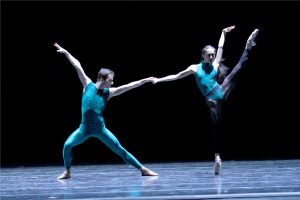
Joffrey Ballet dancers in “In the Middle, Somewhat Elevated.” Photo: Herbert Migdoll
Thom Willems’ electronic score was a head banger that heaved and clanged till it hurt – to be kind, an acquired taste that grows on you. Forsythe’s exploited themes and variations hinted at Balanchine, even Petipa, but familiar pique turns and arm alignments became distorted. Harsh lighting added to the industrial setting and cast shadows, almost obscuring faces.
Dancers kicked wildly and posed mechanically in forced off center extensions. There were a few soft moments, such as a man pulling a woman as if her feet were gliding on ice. Basic leotards, with tights pulled over them for the women, suggested a strict dance rehearsal, but red hot chemistry and vertical extensions crossed into dangerous territory. At times, the dancers seemed to be hunting each other, eyeing each other as prey.
Since its inception in 1956, when Robert Joffrey sent six dancers, including Gerald Arpino, on tour in a station wagon while he stayed back in New York teaching to pay salaries, the Joffrey has specialized in mixing modern classics and new works. (Dance historians may remember that Merce Cunningham and his friend John Cage took a similar roadtrip. They took off in a van, with Merce at the wheel).
But I digress. All of that touring inspired Joffrey and and Arpino. Joffrey’s fertility god inspired “Astarte,” was probably the first rock ballet. His dance “Jackpot” included themes about orgasms and psychedelic lights. He took a big risk when he commissioned Twyla Tharp’s “Deuce Coupe;” then considered a cross-over work, it has paid off handsomely.
Joffrey and Arpino have passed on. The company has moved from New York to Los Angeles, and now has a permanent home in Chicago’s Joffrey Tower on the Loop. Ashley Wheater became artistic director in 2007, and he continues to cast this exceptional ensemble in bold new works.
Along with Forsythe, this program included works by Stanton Welch, and Christopher Wheeldon.
In Wheeldon’s “After the Rain,” set to the enchanting and familiar sounds of Arvo Part’s Tabula Rasa and Spiegel im Spiegel, bodies as sculpture gradually became as meditative as the strings and piano they move to.
The pas de deux within the piece could easily stand alone. Delicate, flexible backs and flawless lifts made it one of the most beautiful and ethereal duets I’ve seen in a decade. My only complaint is that the score, Spiegel im Spiegel, which translates,” Mirror in the Mirror,” wasn’t played live. Had that been the case, a few thousand viewers may have levitated out of their seats. Still, the sound quality was excellent.
Wheeldon’s genius in the duet is leaving lots of open space, as the music does, to let viewers ponder endless possibilities.
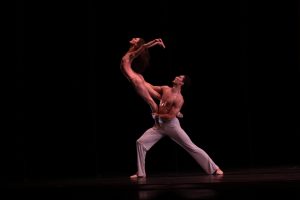
Joffrey Ballet dancers in “After the Rain.” Photo: Herbert Migdoll
Though the dance had no narrative, with each slow pull and arching backbend to the floor, the urge was to insert a story of lovers, past or present, or a perhaps a celestial fantasy. Fleeting images are burned to memory, like the easy shifting of two pairs of knees to the side as if napping on a cloud, the man lifting the woman at the waist as she surrenders in full backbend with her palms flexed, and those hesitation breaths before starting it all again.
The program opened with “Son of a Chamber Symphony,” by Welch that premiered at Jacob’s Pillow in Aug. 2012, and set to John Adams’ score of the same name.
The work is distinctly contemporary, and in effect, a playful homage to old ballets. Viewers could search for choreographic allusions or not, such as daring lifts known as fish dives from “Swan Lake,” and complex partnering from Balanchine’s “Emeralds,” or “Rubies.” Funny thing, those antique elements in “Chamber” created a strange futuristic narrative.
The opening showcased the very handsome and trim Joffrey men, who marched on autopilot to surround a quivering woman trying to hide in a pool of light.
Fairyland costumes (by Travis Halsey) were effective and humorous.
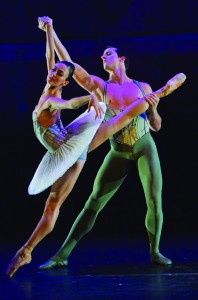
Joffrey Ballet dancers in “Son of Chamber Symphony.” Photo: Christopher Duggan
Wafer thin tutus with a ribbed underside evocative of delicate mushroom caps flopped and folded at just the right time, to keep the men and women separated during close contact. Brilliant green leggings for the men sparked images of giant dancing asparagus or androids with gorgeous feet. The men also sported tank tops with cutouts, designed to expose their nipples, while the women had classic bodice tops. My date whispered that he wished they were reversed. We then imagined that someone – or something – had taken a ballet correspondence course and misread most of the directions.
If you missed this program, drive fast to LA Music Center, Dorothy Chandler Pavilion, Los Angeles. Feb. 1-3.
La Jolla Music Society’s Dance Season continues with Alvin Ailey, Apr. 9 and 10, 2013, at Symphony Hall. Shows begin at 8 pm. Prelude – Lectures by Marcus Overton begin at 7 pm.
No results.
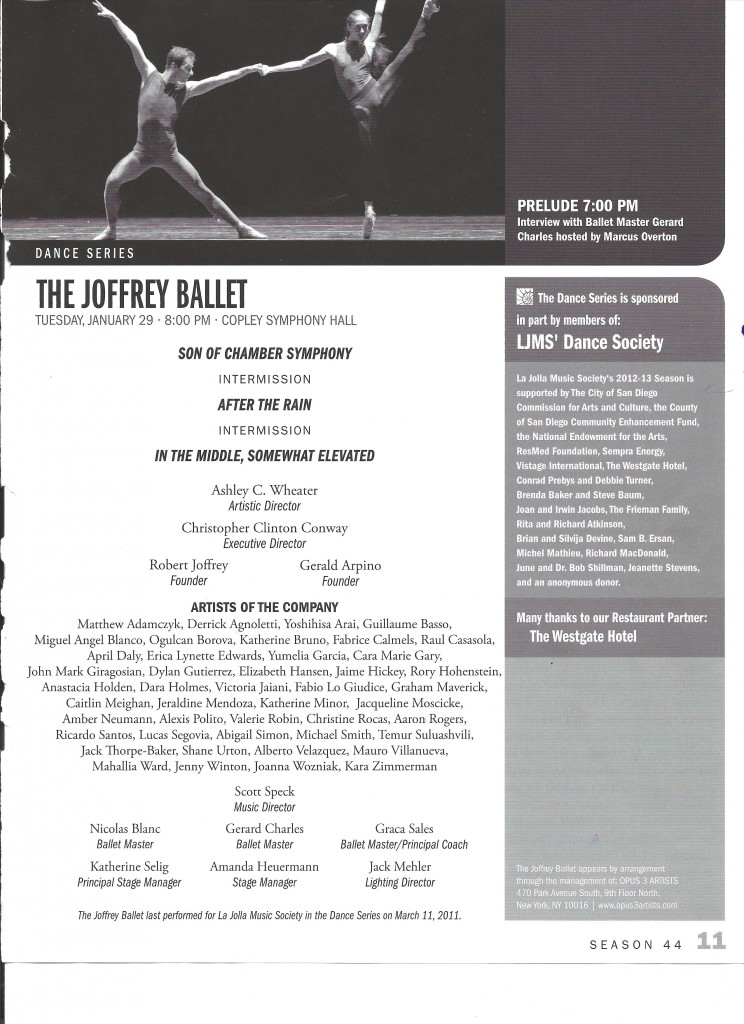
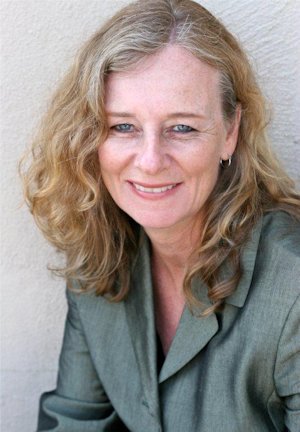
Kris Eitland covers dance and theater for Sandiegostory.com and freelances for other publications, including the Union Tribune and Dance Teacher Magazine. She grew up performing many dance styles and continued intensive modern dance and choreography at the Univ. of Minnesota, Duluth, and San Diego State Univ. She also holds a journalism degree from SDSU. Her career includes stints in commercial and public radio news production.
Eitland has won numerous Excellence in Journalism awards for criticism and reporting from the San Diego Press Club. She has served on the Press Club board since 2011 and is a past president. She is a co-founder of Sandiegostory.com. She has a passion for the arts, throwing parties with dancing and singing, and cruising the Pacific in her family’s vintage trawler. She trains dogs, skis, and loves seasonal trips to her home state of Minnesota.

An insightful account of a rich program of modern dance–thank you! But I think you were much too kind describing Willems’ hideous electronic score as something “that grows on you,” unless, of course, you were comparing it to gangrene.
One small point: the company’s home in Chicago would be properly described as in the Loop, that portion of downtown Chicago encircled by the elevated trains. A building on the Loop would be literally on the “el” tracks, an uncomfortable location for artistic endeavors. Of course, if that were the case, they wouldn’t have to pay Willems royalties for using his music, since recording 30 minutes of rush-hour trains clanking and screaming by could be substituted with little evident difference.